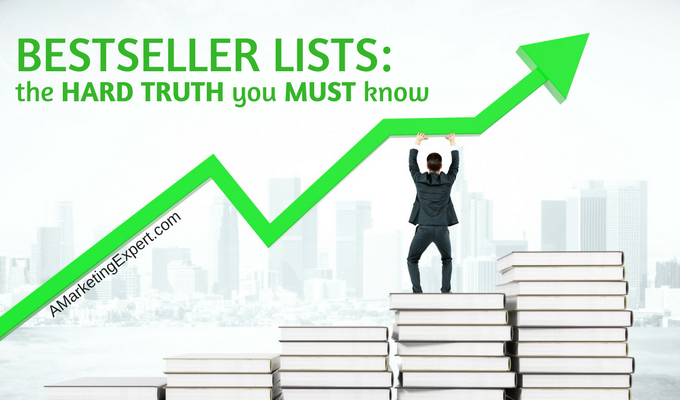Do you want to be a bestseller? If you ask any indie author, they’ll eagerly nod yes. But are bestseller lists still relevant? The panache of having a bestselling book is fantastic and certainly, the mainstream publishing industry still gives a nod to a bestseller, but for how long? In 2016, there were no breakout bestsellers, at least not like we’ve seen in years past. It may be that this is a trend. It’s certainly worth watching. With so much weight and power shifting from traditional publishing to the independent side of things, book sales just aren’t tabulated the way they once were.
So does “bestseller” really mean more sales? Not necessarily and here’s why:
Bestseller lists are changing all the time – the rules are changing and the way books are ranked shifts constantly. This is largely due to the sheer number of books that are flooding the market. With 4,500+ books published daily, the lists simply cannot adapt to these changes. Independently published books have the potential to affect the bestseller lists, especially if they hit big numbers. It’s important to really understand the word “bestseller,” because as we’ve seen with the recent Amazon crackdown of using terms like “bestseller” on your book cover (read more on this here), it can be a slippery slope.
First off, the term “hit a list” can mean hitting a bestseller list at any point of entry, including the bottom 100. In fact, many books that “hit a list” are never viewed by consumers; they land on one or more bestseller lists, stay for a week or so, and then vanish. The numbers and metrics for this can be tricky and are not always entirely accurate. If you’ve ever tried to hit a list and found yourself disgusted with the odds, I hope this article sheds some light on the realities of how the process works.
How Bestseller Lists Work
Bestseller lists vary by season, market, and genre. Surprisingly enough, how many copies you need to sell to be a “bestseller” often depends on when you release it. Pre-Christmas releases, for example, require bigger numbers than May releases. Why? The hotter the month (not in temperature but in publishing releases) the harder it is to get onto a list.
Reporting is another key factor, especially because not all reporting is accurate and often slow. You could hit 20,000 sales in October and not see the numbers until November. Moreover, sales reporting can also be inaccurate. Did you know that there’s a whole market share that’s never reported? Technical, scholarly, and law-related books can make up a large chunk of the book market and are never reported. Christian titles work the same way. You might say, “Well, what about The Shack?” This Christian title is different and hit a list because it was sold en masse in retail outlets and not sequestered to Christian retailers that don’t get the benefit of reporting to the lists.
Then there’s the Amazon factor, and big box retailers, which complicate the “bestseller” issue further. Nielson’s BookScan is the keeper of the numbers and, according to my research, BookScan does not report on self-publishing companies like Createspace or Amazon’s new KDP print book platform. They also don’t include Sam’s Club, WalMart, and Costco. Furthermore, BookScan cannot access all of Amazon’s numbers, only sales that are directly tied to an ISBN. If your eBook publishes without an ISBN (instead using Amazon’s ASIN system) BookScan does not count it. Some sources say BookScan does not report on 75 to 85% of sales but I’d bet that number is actually lower (in terms of what BookScan reports on) because if you consider the lists of technical, scholarly, law-related books, the Christian market, the millions of self-published titles each year, and all of the eBooks that use Amazon’s ASIN system, I’d wager a guess that BookScan gets maybe 65-70% of the market. Although you might argue that indie and eBook-only books don’t matter in the bestseller counts, you could be right. With that said, I recently spoke with an eBook-only indie author with 52 titles who sells 20k books per month. While that 20k number is high, it’s divided amongst all of her books. Still, it’s a reasonable assumption that counting her sales total via BookScan could be a gamechanger.
The Bestseller Structure and How Lists are Tabulated
Each list pulls book data differently, meaning that the New York Times does not pull book data from BookScan. Instead they cull their list by using a super-secret list of stores reporting from across the country, and it’s how they’ve always done it. Their lists are specific to what’s hot and selling in these stores and not at all based on BookScan numbers – which may be good, since we now know what BookScan reports and what they don’t. USA Today and The Wall Street Journal do, however, base their bestseller lists on BookScan’s sales numbers. One fly in the ointment is that eBooks are separated from print, because this can skew the numbers greatly. If an author sells large numbers each of their eBook and print versions, they might not hit a list since the digital copy and print weren’t tabulated together. While it’s great that eBooks are even getting acknowledged in bestseller lists, I’m certain that separating out these numbers has significantly impacted reporting.
As I said earlier, seasons can make a difference along with any advanced buzz. Publishing is often about perception and any advance buzz a book is getting will help it land on a list. Generally, a book that is just “born” into the publishing world with no buzz or advance reviews won’t capture the attention of a big list. The author might perform well locally, but generally not nationally unless (like the Fifty Shades phenomena) an online viral buzz builds. Sales surge should also be considered; it often happens during a very short interval and doesn’t always have to equate to huge numbers. Instead the velocity of the push is what matters. An associate of mine in publishing once told me that a book she was working with only sold 4,000 copies before it landed on a major list. The smallness of the number is staggering when you think about it even when considering that this book hit a list during a slow period, which worked in its favor.
Grey Areas and Genres Not Reported
As I mentioned previously, certain genres (namely Christian, technical, scholarly, and the like) aren’t reported. And while many of these don’t sell in big numbers and perhaps it makes sense not to tally them, the other sticky piece is bulk purchases.
What’s a bulk purchase? Let’s say that a book club wants to buy your book for their membership and they purchase 10 copies from Amazon. If these 10 books are purchased from the same IP address, it counts as one book. By the same token, if big, bulk purchases of your book are legitimately bought by an organization for gifting to their members or as a fundraiser or whatever, this number is also not counted by the Wall Street Journal and, potentially, other bestseller lists as well. The reason for this will be covered in the “rigging a list” section below.
Rigging a List
Some years ago, we worked on a book that hit a bestseller list and it was a wonderful thing until someone discovered the author had bought up copies on their own, in order to tweak the numbers.
Yes, you can, in fact, rig a bestseller list. There are companies who will buy up your book for you. You pay them a fee, and then another fee for the cost of the books and voila, a bestseller! How much does this cost? Well, upwards of $30,000 -$50,000. Is it worth it? Well for me, I’d rather hit a list the old-fashioned way, by writing a book that’s so good, that it sells like hot cakes, but not everyone agrees with this. I’ve spoken to authors who are doing this and I really think it’s a terrible way to get on a list.
Some years ago, you could contact 20,000 of your closest friends, ask them to go onto Amazon and buy up copies of your book and voila – instant bestseller! This doesn’t work quite the same, since Amazon got onto the whole bulk/grouping buying thing. But there was a time when these companies existing to just buy up your book could really help you hit a list.
Does it Matter, Really?
Over the years, we’ve worked with a lot of bestsellers and while it’s fun, glamorous and awesome to be a part of, for most indie authors this isn’t reality. I see the lists changing, and I see (more and more) indie authors succeeding with big sales numbers and literally killin’ it on their own. Would a bestseller status help them to ratchet it all up a notch? Probably, but the problem is that most indie authors can’t get there because the system isn’t working in their favor. The other piece of this is the cost. While there is the occasional book that will pop out and become a success after its release, most books need major, national pushes well before the book is out. Books sold into bookstores is becoming something only reserved for the brand name authors or big, breakout books that are getting a lot of buzz. But when it comes to hitting national bestseller lists, bookstores still help those numbers along. If you aren’t nationally distributed, if you haven’t gone after long-lead, pre-publication reviews, you may want to set your dreams of a New York Times Bestseller aside and focus instead on more productive book marketing efforts.
What about Amazon? Truthfully, you could hit the Amazon bestseller list any time. You book doesn’t have to be brand, spanking new (though it helps), just keep in mind that of all of the retailers out there, Amazon sees the bulk of what’s being published so the competition is fierce.
This piece is not an attempt to be a buzzkill, nor do I want to tank your hopes and dreams of becoming a bestselling author. But so many times I see indie authors with one, singular focus: hitting a list. And while that’s great, it’s just not always a realistic goal. Instead, spend your book marketing efforts building sales channels, engaging readers and building things that will last for the duration of your career. These are the ingredients for an (eventual) bestseller.





Interesting post.
“Reporting is another key factor, especially because not all reporting is accurate and often slow.”
It’s tragic that with modern technology, we can’t have data updated hourly or daily. Having said that, Amazon can shoot a book in and out of its Best Seller classification minute by minute. As long as a book is #1 in any category, it shows on the main sales page with a yellow Best Seller ribbon.
Kathy that’s very true – Amazon does update hourly, which is pretty amazing. Thanks for reading! Glad you enjoyed the article!
Penny,
I have learned so much from you over the years, and I still have your “From Book to Bestseller” on my desk. Thank you for always sharing such insightful information.
I did not realize Christian publishing was not included. In the article, you reference the difference with “The Shack.” Is this also true of Karen Kingsbury’s novels? Her covers also tout “New York Times” bestselling author.
Sometimes books like The Shack, do cross-over. That’s probably what happened in Karen’s case, too!